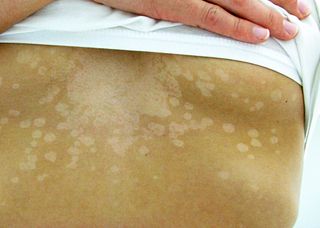
Tinea versicolor is a fungal infection of the skin caused by the skin’s natural yeast. It manifests itself as a rash. It’s relatively easy to kill the infection, but the skin often remains discolored for months, and the infection frequently recurs in many patients. The infection can occur in people of all ages and skin colors, but those with oily skin, weak immune systems, or the propensity to sweat are most prone to developing the infection. Here’s what you should know about tinea versicolor.
Symptoms
The biggest signs of an infection are patches of discolored skin, which may be lighter or darker than the surrounding area. They most commonly occur on the arms, neck, chest, and back, but they may be found anywhere on the body. Sometimes the rash is made worse by warm and humid weather, and it may disappear during cooler weather. The patches usually don’t hurt, but they may be dry or itchy.
Treatment
Mild cases can often be treated at home with an over-the-counter product. Anyone with a mild case may want to consider purchasing a shampoo containing selenium sulfide or an anti-fungal cream or ointment containing miconazole, clotrimazole, or terbinafine. If the skin hasn’t improved after four weeks, it’s time to see a professional. Dermatologists can often make the diagnosis just by looking at the skin, but if there’s any uncertainty, they may scrape off some skin cells or examine the skin with a special device. Your doctor may prescribe a stronger, more effective treatment like anti-fungal medication to control the infection.
Minimizing Symptoms
There are steps that patients can take to minimize the impact of tinea versicolor. These include wearing loose clothing and using non-comedogenic or non-oily products. The rash appears darker on tanned skin, so wear sunscreen and avoid tanning beds. Look for broad-spectrum products that offer both UVA and UVB protection in at least SPF 30. (Don’t forget to get a non-comedogenic formula!)
If you suspect that you may have tinea versicolor, call to schedule an appointment to learn more about the condition and the treatment options available to you.
